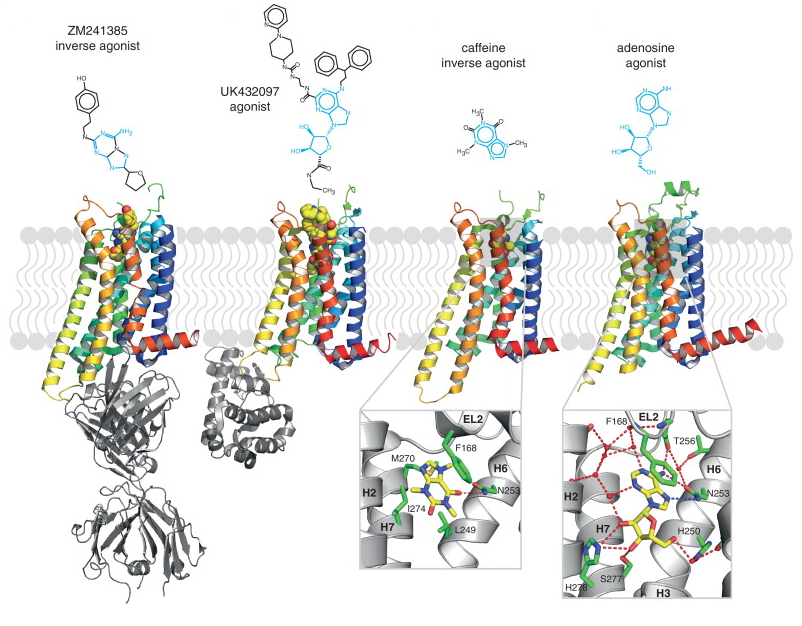Adenosine Receptors
The main focus for the development of adenosine targets as
analgesics to date has been A1RS due to its antinociceptive profile in various preclinical pain models.
The usefulness of systemic A1R agonists may be limited by other effects (cardiovascular,
motor), but enhanced selectivity for pain might occur with partial agonists, potent
and highly selective agonists, or allosteric modulators.
A2AR agonists exhibit some peripheral pronociceptive effects, but also act on immune cells
to suppress inflammation and on spinal glia to suppress pain signaling and may be useful for
inflammatory and neuropathic pain. A2BR agonists exhibit peripheral
proinflammatory effects on immune cells, but also spinal antinociceptive effects
similar to A2AR agonists.
A3Rs are now demonstrated to produce antinociception in
several preclinical neuropathic pain models, with mechan
istic actions on glial cells, and may be useful for neuropathic pain.
Endogenous adenosine levels can be augmented by inhibition of metabolism
(via adenosine kinase) or increased generation (via nucleotidases), and
these approaches have implications for pain.
Endogenous adenosine contributes to antinociception by
several pharmacological agents, herbal remedies, acupuncture, transcutaneous
electrical nerve stimulation, exercise, joint mobilization, and water immersion via
spinal and/or peripheral effects, such that this system appears to constitute a
major pain regulatory system.
All adenosine receptors have effects on spinal glial cells
in regulating nociception, and gender differences in the involvement of such cells
in chronic neuropathic pain indicate gender may also need attention in preclinical a
nd human trials evaluating
the efficacy of adenosine-based analgesics.
The recently solved crystal structures of A1 and A2AARs support both homology
modeling studies and structure-based drug design approaches.
Our scientific efforts focus on an iterative, bi-directional approach in
which models are used to generate hypotheses that are tested by experimentation
and the experimental findings are, in turn, used to refine the model.
The success of this approach is due to the synergistic interaction between theory and experiment.
Recent Publications
-
Petrelli, R.; Scortichini, M.; Kachler, S.; Boccella, S.; Cerchia, C.; Torquati, I.; Del Bello,
F.; Salvemini, D.; Novellino, E.; Luongo, L.; Maione, S.; Jacobson, K.; Lavecchia, A.; Klotz, K.-N.; Cappellacci, L.;
Exploring the role of N6-Substituited in Potent Dual Acting 5'-C-Ethyl-Tetrazolyl-Adenosine Derivatives: Synthesis, binding,
Functional Assay and Antinociceptive Effect in Mice. J. Med. Chem. 2017, 60, 4327-4341
-
Caiazzo; E.; Maione; F.; Morello; S.; Lapucci; A.; Paccosi; S.; Steckel; B.; Lavecchia, A.;
Parenti; A.; Iuvone; T.; Schrader; J.; Ialenti; A.; Cicala, C.;
Adenosine Signalling Mediates the Anti-Inflammatory Effects of the COX-2 Inhibitor Nimesulide.
Biochem. Pharm. 2016, 112, 72-81.
-
Petrelli, R.; Torquati, I.; Kachler, S.; Luongo, L.; Maione, S.; Franchetti, P.; Grifantini, M.; Novellino, E.;
Lavecchia, A.; Klotz, K-N, Cappellacci, L.;
5’-C-Tetrazolyl-Ethyl-N6-Substituted Adenosine and 2-Chloro-Adenosine Derivatives as Highly Potent Dual
Acting A1 Adenosine Receptor Agonists and A3 Adenosine Receptor Antagonists.
J. Med. Chem. 2015, 58, 2560-2566.
-
Franchetti, P.; Cappellacci, L.; Vita, P.; Petrelli, R.;
Lavecchia, A.; Falgner, N.; Kachler, S.; Klotz, K.-N.; Marabese, I.; Luongo, L.; Maione, S.; G
rifantini, M.
N6-Cycloalkyl- and N6-Bicycloalkyl-C5'(C2')-Modified Adenosine Derivatives As
High-Affinity and Selective Agonists at the Human A1 Adenosine Receptor with Antinoc
iceptive Effects in Mice.
J. Med. Chem. 2009, 52, 2393-2406.


